The AMD Ryzen AI 9 HX 370 Review: Unleashing Zen 5 and RDNA 3.5 Into Notebooks
by Gavin Bonshor on July 28, 2024 9:00 AM ESTConclusion
This year is perhaps one of the busiest of this decade for the PC, both in terms of the competitive landscape and how each chip manufacturer is trying to stay ahead of the other. If you've been keeping your ear close to the ground, looking to hear about what's coming around the corner or even what's going to be the next big thing (yes, RGB, you've had your day), then the most commonly used phrase when mentioned alongside the PC is AI. It's not just a buzzword, but it's an entire market driver with a lot of weight being pushed behind it from all sides.
Regardless of the opinion on AI, the AI PC, or what the AI PC actually is, more and more consumer hardware is coming equipped with AI on the chip. The first to market in the consumer space with a dedicated AI engine in the notebook space was AMD with their Zen 4-based Phoenix Point or the Ryzen 7040 series. Not to be outdone, but both Intel and even Quallcom have mobile processors with a Neural Processing Unit, or NPU as they are commonly known. It's less of a race to get AI on the PC, but it's more about who has the biggest TOPS.
Touching on who currently has the biggest and meanest NPU on-chip in the notebook market with the highest TOPS is AMD, with the new XDNA 2 NPU architecture bringing this (current) victory to team AMD with the launch of the Ryzen AI 300 series, codenamed Strix Point. The Ryzen AI 300 series not only brings the highest TOPS from an NPU out, but it also marks the launch of AMD's latest Zen 5 microarchitecture. Even further, AMD has also brought their compact Zen 5c cores out on the same day as the main architecture, which is something they haven't done before; the compact cores usually come much later in the release cycle.
Today, AMD launches their Ryzen AI 300 series SoCs to the world, with a mixture of full-fat Zen 5 cores and the compact Zen 5c cores on the same die; they are, however, on their own CCXs. There are three chips at present, with the third being a late announcement, the Ryzen AI 9 HX 375, which actually has an XDNA 2 NPU, which is claimed to have 55 TOPS of AI performance under its hood. However, the rest of it is the same as the SoC we've been reviewing today, courtesy of the new ASUS Zenbook S 16 UM5606, which uses the AMD Ryzen AI 9 HX 370 to drive both compute and graphics.
The AMD Ryzen AI 9 HX 370 not only marks a new nomenclature, it not only brings the highest level of TOPS to notebooks on the market, but it also brings with it a new CPU core, Zen 5, which is built on TSMC's N4P (4 nm) node, but it also brings friends to the party. On top of the new XDNA 2 NPU, which is much faster than the previous NPU found in Phoenix and Hawk Point, it also brings the RDNA 3.5 graphics architecture, which looks to bring a whole host of improvements over RDNA 3 in terms of gaming performance.
Coming with a 12C/24T design, which consists of 4 x Zen 5 (full size) cores alongside 8 x Zen 5c (compact) cores, it has a base frequency of just 2.0 GHz, but the full-fat Zen 5 cores can boost all the way up to 5.1 GHz. Although it has a variable TDP of between 15 and 54 W, inside of the Zenbook S 16, it's configured at AMD's default TDP, which is 28 W. This puts it on parallel power-wise with Intel's Meteor Lake SoC chips. In contrast, the Ryzen 8040HS series had chips that started at 35 W and could be configured up to 54 W depending on the caliber of notebook or laptop it came in. However, TDPs aside, Zen 5 has finally arrived, and it's time to analyze how it currently shapes up in the mobile space.
Ryzen AI 9 HX 370 Performance Analysis
In this review, we not only tested the AMD Ryzen AI 9 HX 370 SoC (12C/24T) with the new Radeon 890M integrated graphics, but we've put it up against what it's replacing in the Zen 4 based Ryzen 9 7940HS (8C/16T) which has the RDNA 3 based Radeon 780M graphics. Intel's current Meteor Lake SoC, with the Intel Core Ultra 7 155H showcased in two notebooks, is also included.
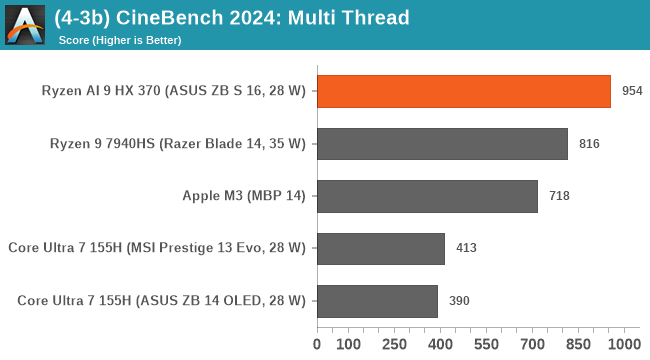
First up, the Ryzen AI 9 HX 370 didn't really appear to be anything special in the office and encoding sections of our CPU suite, with middling performance competitive with everything else. It put everything else to bed, though, and allowed the new Zen 5 cores (and Zen 5c) to stretch their proverbial legs. In the Cinebench 2024 rendering benchmark with the multi-threaded test selected, we saw the Ryzen AI 9 HX 370 outperform the Zen 4-based Ryzen 9 7940HS by around 17%, which is certainly a good win for Zen 5. It does have more cores, albeit more efficient and compact Zen 5c cores, but winning is winning.
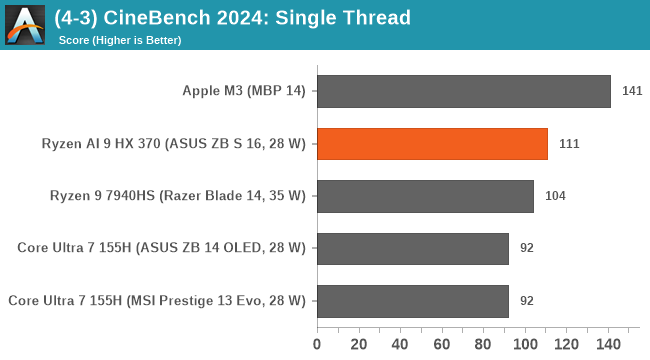
While Zen 5 boasts large IPC gains over Zen 4 (AMD claimed 16% on average), we didn't really see this for ourselves. The Ryzen AI 9 HX 370 still outperformed the 7940HS in the Cinebench 2024 single-threaded test, but it was more like 7% and not the 16% everyone was excited about. Fire up a workload that utilizes AVX-512, and sure, it will demolish, but in typical tasks, not so much.
AMD RDNA 3.5 Delivers Better Gaming Performance Than 3.0
Comparing RDNA 3 (Radeon 780M) to the latest RDNA 3.5 (Radeon 890M) in the Ryzen AI 9 HX 370, we saw improvements across all of our suites, which shows AMD has done wonders to improve their integrated graphics.
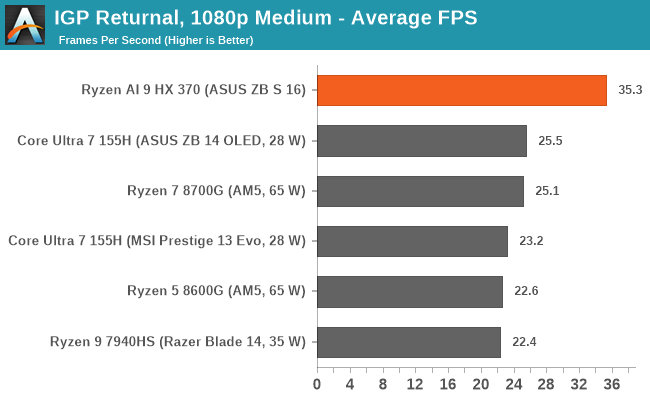
A prime example of AMD making improvements in performance over the last generation with the new Zen 5/Zen 5c SoC is in Returnal at 1080p with the medium preset selected. It managed to outperform the Ryzen 9 7940HS by 57%. While this isn't going to be the case in every game, we did see a consistent advantage to the Ryzen AI 9 HX 370 over the previous Phoenix Point-based 7940HS.
Overall, the combination of Zen 5 cores coupled with the RDNA 3.5-based Radeon 890M delivers better performance in gaming than the Phoenix-based Zen 4 predecessor and it also keeps Intel's current Meteor Lake SoC at bay. Still, it has to be said that integrated graphics still aren't quite there when it comes to delivering 1080p/60fps gaming, especially in big titles or AAA games, as they are more widely known. In lesser intensive games such as League of Legends, DOTA 2, and Faster Than Light.
The ASUS Zenbook S 16 UM5606: Sleek, Elegant and Highly Relevant
It wouldn't be fair to wrap up the Ryzen AI 9 HX 370 review without first giving some feedback and attention to ASUS's new Zenbook S 16 ultraportable notebook. The first thing to touch on is the design and overall composition of the Zenbook S 16's look and feel. First of all, the color is called 'Scandinavian White,' but to me, it looks more like a matte light silver, which isn't a complaint from me because it looks really good, especially when the sun shines on it. Secondly, it certainly looks lighter than it appears to be, but it's still lighter than the Apple 16-inch MacBook Pro with the M3 Max and most 16-inch notebooks, to be honest. It's deceptive how stylish and cloud-like it looks, but that's just my perception of how much it weighs compared to how I thought it was going to weigh based on how it looks.
Moving on, of course, the AMD Ryzen AI 9 HX 370 is going to take much of the plaudits, but the Zenbook 16 S certainly deserves some plaudits, too. It's thin at just 11.9 mm thick and includes plenty of nice subtle features, including thin bezels around the 16-inch Lumina OLED touchscreen display and an elegant white backlit keyboard that looks good when the lights get dimmed.
Of course, not everything is about looks, and at the heart of everything making it beat is the AMD Ryzen AI 9 HX 370. The ASUS Zenbook S 16 UM5606 itself, though, looks and feels as premium as any high-end notebook; it's packed with AI-integrated software features and applications for users to dive into if that's their thing. The chassis is made from ASUS's own material called 'Ceraluminum.' ASUS describes it as a high-tech ceramic designed to be both robust and light, with the naming sort of implying that it combines ceramic and aluminum. The result is a simple yet striking design that feels every bit as premium as it looks.
The ASUS Zenbook S 16 UM5606 starts at $1699 and is available now at retailers and on ASUS's website.
Final Thoughts: Ryzen AI 9 HX 370 Delivers in Intensive Loads, and RDNA 3.5 Does Well
AMD has firmly positioned itself at the forefront of the notebook market with the launch of the Ryzen AI 300 series, with Zen 5 being the star of the show. Zen 5 is the latest microarchitecture in AMD's roadmap and brings a host of improved architectures on key parts of the die itself. This includes the XDNA 2 NPU, which looks set to drive Microsoft Copilot+ AI-driven software into action and potentially push what NPUs and AI on-chip can do even more as we head into 2025.
AMD also has the updated and upgraded RDNA 3.5 integrated graphics to help drive things forward, but again, it still doesn't compete with discrete graphics in terms of gaming performance. In contrast, it's designed more for premium ultrathin notebooks such as the ASUS Zenbook S 16, which seems a fitting launch platform for it.
Although the Ryzen AI 9 HX 370 with four regular Zen 5 cores and eight compact Zen 5c cores performed pretty well in multiple areas, it certainly did it when it counted, especially in more intensive workloads such as rendering. Less intensive workloads didn't really didn't tax it too much, and in those cases, it was pretty average in all honesty. In regular and real-world scenarios and workloads, we certainly didn't see up to a 16% increase in IPC performance, but the key is that Zen 5 has improved IPC over Zen 4.
The Ryzen AI 300 series, including the Ryzen AI 9 HX 370, looks set to ignite a 'battle of the TOPS' where Generative AI performance is concerned among the main chip makers. Still, now that we've got Zen 5 in mobile, it'll be time soon to pivot towards Zen 5 for desktop, with the launch of the Ryzen 9000 series coming fast. In fact, it's in less than two weeks ever since AMD delayed the launch, so it'll be interesting to see how Zen 5 compares to Zen 4 on the desktop, which is certainly a much hotter battleground.


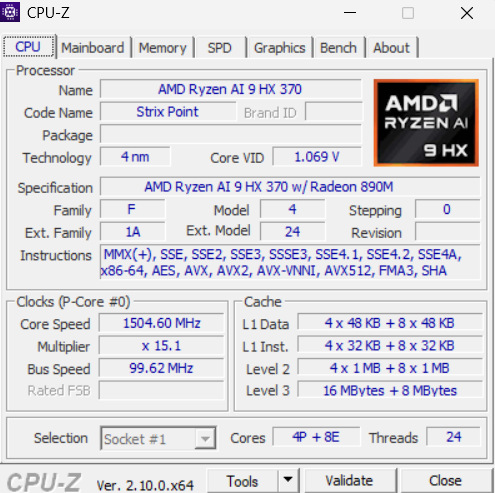

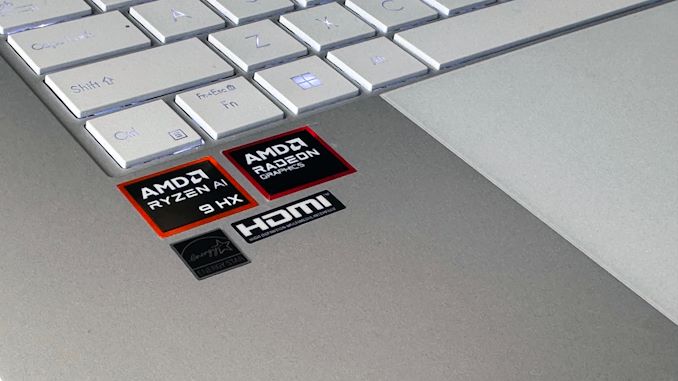








72 Comments
View All Comments
Dante Verizon - Sunday, July 28, 2024 - link
Why are you comparing an ultra-thin design to a CPU with PL2 at almost 90w? The notebookcheck tests show that the Zenbook runs up to 50% slower than the ProArt chassy.Ryan Smith - Sunday, July 28, 2024 - link
Sorry, which notebook are you referring to? We have multiple Zenbooks here.Terry_Craig - Sunday, July 28, 2024 - link
He's probably talking about the Zenbook in the review: https://www.notebookcheck.net/Asus-Zenbook-S-16-la...Strix performs much worse on the Zenbook than inside the ProArt, probably due to more aggressive power and temperature management.
Ryan Smith - Sunday, July 28, 2024 - link
It's definitely not a high performance chassis, despite being 16-inches. The default TDP is just 17 Watts; AMD asked reviewers to bump it up to 28W.But this is what AMD sent out for review. Given the wide range of laptop TDPs out there, these review unit laptops can never cover the full spectrum. So it's more a reflection of what power level/form factor the chipmaker is choosing to prioritize in this generation.
The Hardcard - Sunday, July 28, 2024 - link
What is the 90W laptop in this review? The other laptops are listed at 28W and 35W here. I did not see any indication of the power specifications of the ProArt on the other site, just some numbers provided. I strongly suspect that laptop is running at top TDP, 45-54W.So, like, a different comparison.
Terry_Craig - Sunday, July 28, 2024 - link
https://www.notebookcheck.net/AMD-Ryzen-9-7940HS-P...Depending on the model, the 7940HS goes up to 100w.
The Hardcard - Monday, July 29, 2024 - link
But, is the 7940HS pulling 100w in this review instead of the reported 35w? Otherwise,, what is the point of the complaint?https://www.ultrabookreview.com/69005-asus-proart-...
The HX 370 is in a different chassis pulling 80w sustained. Does that make the 35w vs 28w happening here more fair? I mean, if what the chips can draw elsewhere somehow matters here at all?
eastcoast_pete - Monday, July 29, 2024 - link
It matters if one wants to look at the maximum performance possible, regardless of power draw. But, in addition to what Ryan wrote, the attraction of the HX Series to me is the strong performance at lower power draws. I would have actually liked to see performance comparisons at 17 W, which IMHO is of special interest in such thin and light notebooks. The higher end (> 50 W) will be if interest for Strict Halo, which as far as I can tell is supposed to take on notebooks with smaller dGPUs.ET - Sunday, July 28, 2024 - link
From the benchmarks here, the 370 looks somewhat disappointing on the CPU front, with some losses to 8 cores Zen 4. A hybrid architecture is always a problem. I wonder if future scheduling changes will help or if the small 8MB L3 for the Zen 5c cores is a problem that can't be overcome.The new GPU however looks like a good upgrade over the previous gen.
nandnandnand - Sunday, July 28, 2024 - link
It's hybrid with different cache amounts, but it's also two CCXs instead of one after 3.5 generations of simple 8-cores. It's hard to say what's screwing it up.Phoronix's review was more positive for the CPU. The main benefit is power efficiency:
https://www.phoronix.com/review/amd-ryzen-ai-9-hx-...
The reviews I looked at didn't look too good for the GPU. Maybe it will do better with more power, but what it really needs is memory bandwidth. Hopefully AMD brings some Infinity Cache to its mainstream 128-bit APUs in the future.